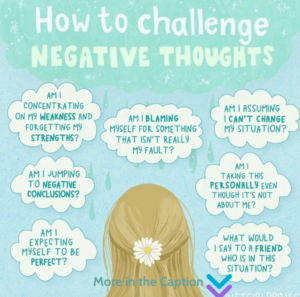Did you know most humans have between 60,000 to 90,000 thoughts a day?!!
Thoughts could be a wonderful source of creativity. Our brain has been designed to protect us, and alert us of possible threats. That is why our thinking energy goes to repetitive and mostly negative thoughts about future speculations or resolve past events.
On top of that, our built-in mechanism to counterbalance these negative thoughts – the frontal lobe -can be easily overridden by fear, sadness, or a traumatic past wound.
How can we change these automatic negative thoughts?
The first step is becoming self-aware of our tendencies to dwell on certain distorted thoughts. Some of those thoughts could be overgeneralization, jumping to conclusions, exaggerations not based on facts, blaming, controlling, taking things personally, self-judging or victimization, among others. None of that contributes to our wellbeing.
So becoming curious about our thought propensities by engaging in self-inquiry can help us identify whether we are supporting or self-sabotaging our capacity for thoughts. That is the first steps towards our joy & contentment.
Challenging negative thoughts is an important part of improving your mental wellbeing and self-confidence.
Here are the main steps to challenge negative thoughts
Gradually, these steps will become automatic, and you will be able to go through them in seconds.
1. Identify the negative thought. Notice when a negative thought enters your mind and identify it. Ask yourself “What thought just crossed my mind?” Try to pinpoint the exact words or images that represent the thought.
2. Question the thought. Ask yourself questions like “Is this thought true?” or “Am I interpreting this situation correctly?” Try to evaluate the thought objectively and question its validity.
3. Gather evidence. Look for evidence that contradicts the negative thought. Think of past experiences, facts, and logic that show the thought may not be entirely true or accurate.
4. Consider alternatives. Reframe the perception of the situation. Think of alternative, more positive ways to interpret the event that triggered the negative thought. Try to imagine how someone else may view the situation differently.
5. Redirect negative thoughts to things you are grateful for. When you notice a negative thought pattern, try to redirect your thoughts to the many beautiful things in your life. We are always blessed with things to be grateful for. Focus your mental energy on things you absolutely love in your life. Over time, this can help “rewire” what your brain will naturally focus on .
6. Practice makes progress. Challenging negative thoughts takes practice. The more you do it, the more it will become an automatic habit and the easier it will get over time. But remain patient with yourself and celebrate every small victory.
With consistent effort and an open mindset, challenging negative thoughts can become second nature and greatly improve your outlook. I hope this overview helps get you started!
In the video below, I share the practice that may completely change the way you see your experience and the world. It is The Ten Second Rule.

Great advice! I ‘ll put it into practice!
Thank you!
So glad you found it beneficial. It takes consistency for it to gradually become a habit.
This is profound! Thank you so much for the insight and guidance!
Thank you, Ariel. I’m so glad it resonates with you!